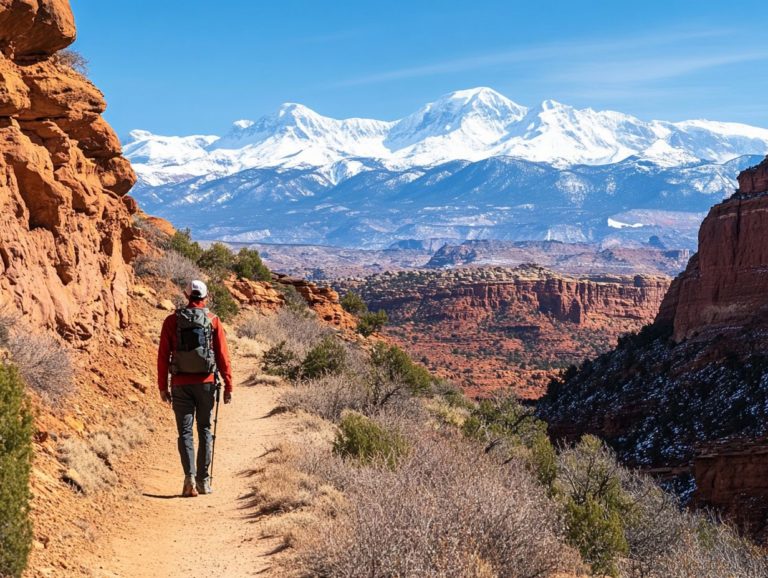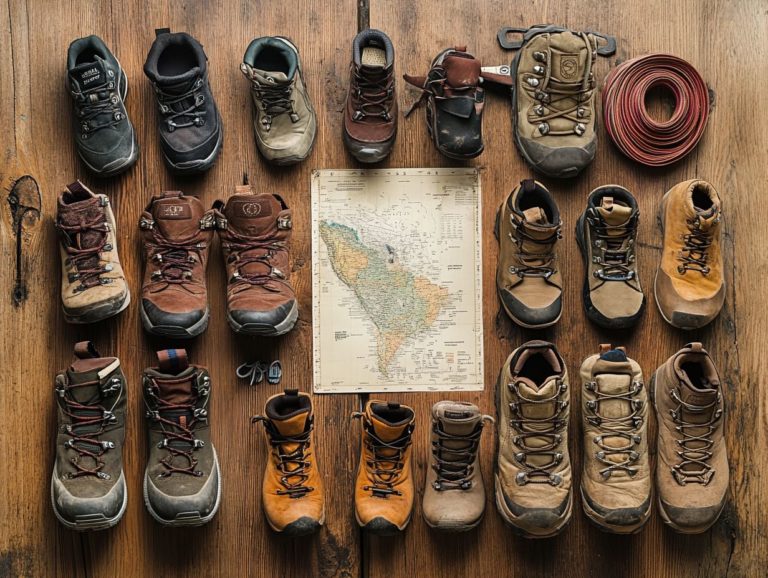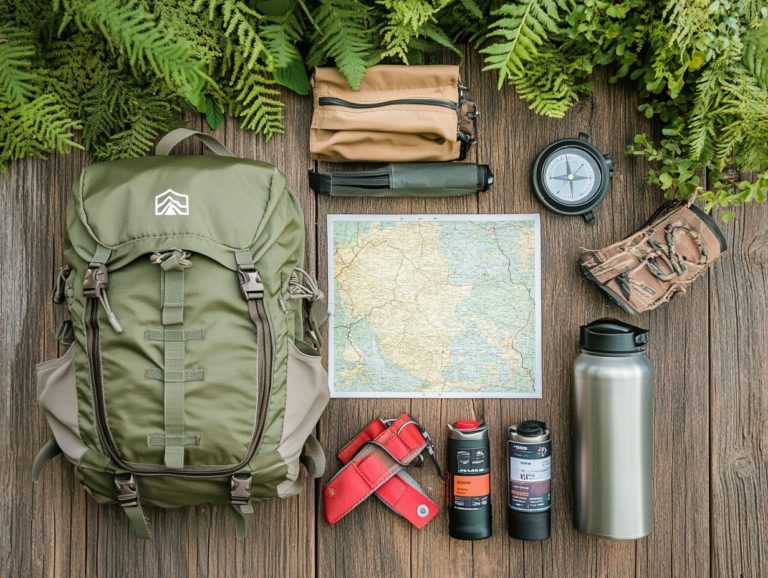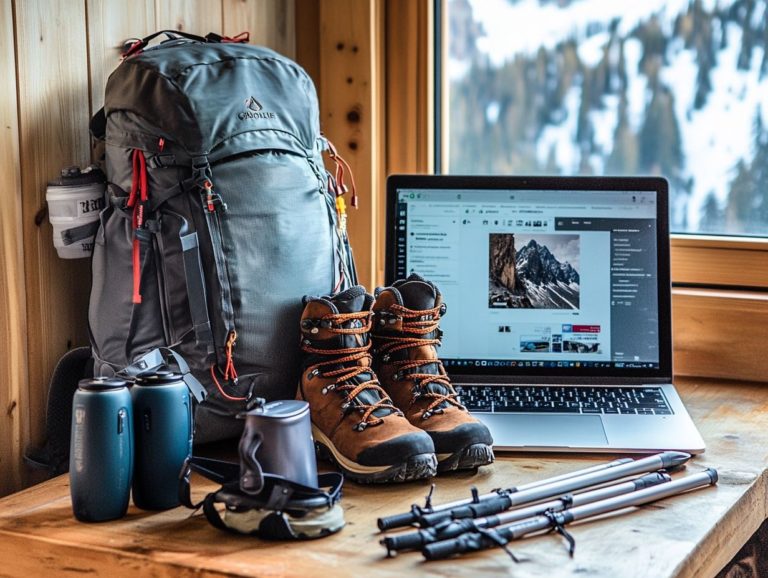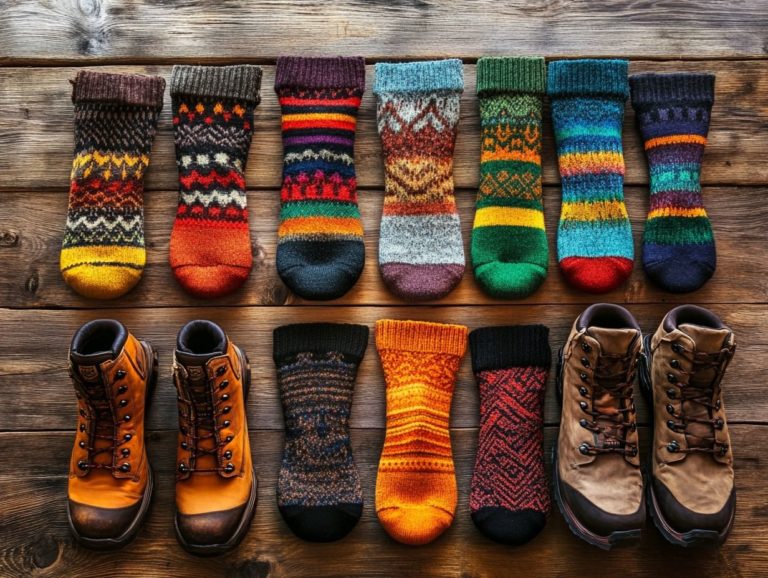Hiking Gear: Must-Have Items for All Seasons
Hiking presents an exhilarating opportunity to connect with nature, but the right gear can significantly enhance your safety and enjoyment.
Whether you re a seasoned adventurer or a newcomer to the trails, being well-prepared is essential for a fulfilling experience.
Here are the must-haves for your next adventure, ranging from appropriate footwear to vital emergency communication devices.
Arm yourself with essential items tailored for every season and scenario, and embark on your next adventure with confidence. Happy hiking!
Contents
- Key Takeaways:
- 1. Proper Footwear
- 2. Comfortable and Durable Backpack
- 3. Navigation Tools
- 4. First Aid Kit
- 5. Appropriate Clothing for the Season
- 6. Hydration System
- 7. Sun Protection
- 8. Portable Shelter
- 9. Emergency Communication Device
- 10. Multi-Tool
- 11. Headlamp or Flashlight
- 12. Insect Repellent
- 13. Whistle
- 14. Extra Food and Snacks
- 15. Personal Items (ID, Cash, etc.)
- How to Choose the Right Hiking Gear for Your Needs?
- Frequently Asked Questions
- What are the must-have items for hiking in all seasons?
- Why is a durable backpack important for hiking in all seasons?
- How do I choose the right hiking boots for all seasons?
- Why is layering clothing important for hiking in all seasons?
- What should I look for in a navigation device for hiking in all seasons?
- Why is it necessary to pack a first aid kit for hiking in all seasons?
Key Takeaways:
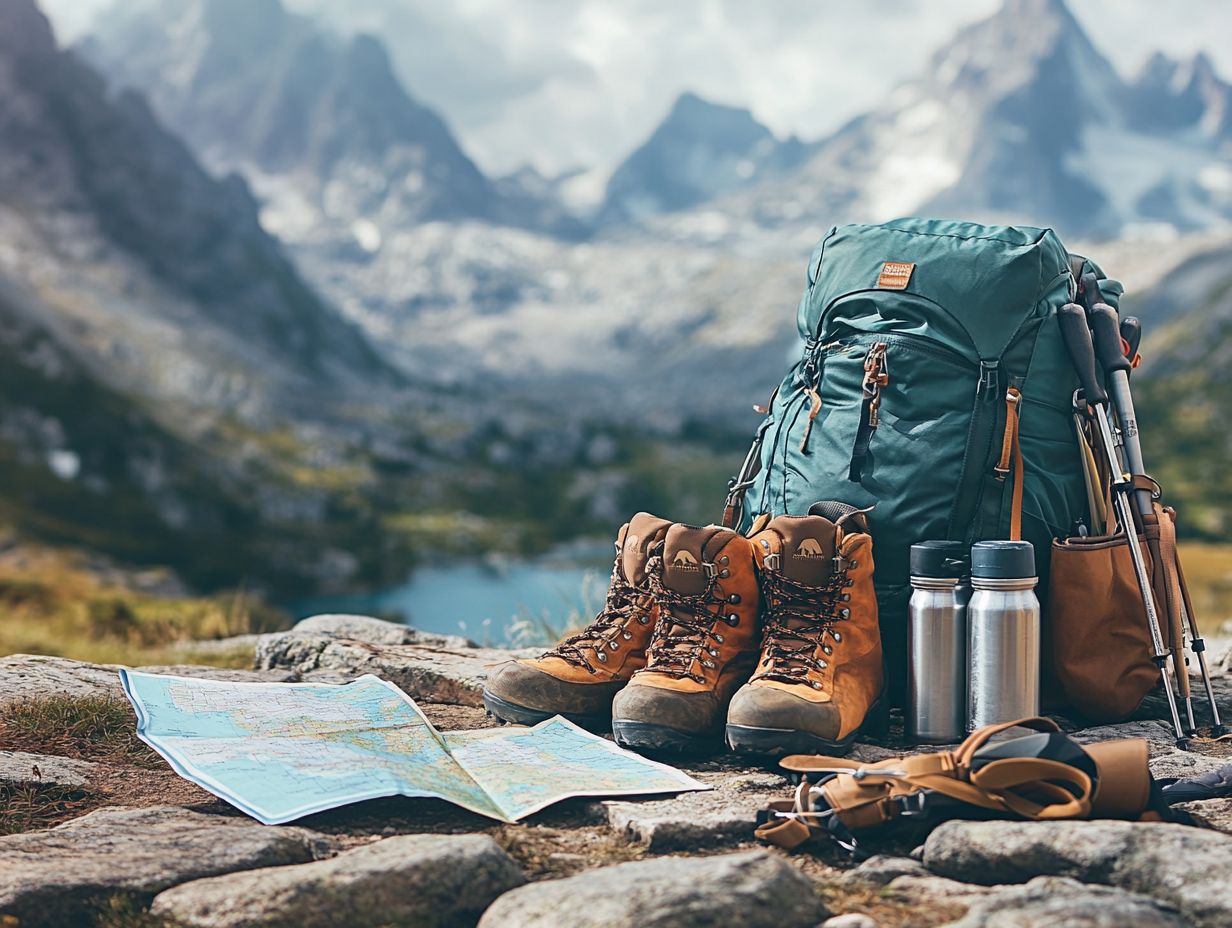
- Invest in proper footwear to protect your feet and prevent injuries during all seasons of hiking.
- A comfortable and durable backpack is an important part of your outdoor gear setup, as it carries your essentials comfortably.
- Bring navigation tools such as a map, compass, or GPS device to ensure you stay on the right trail and reach your destination safely.
1. Proper Footwear
Proper footwear is essential for any hiking adventure. The right hiking shoes not only provide comfort, but they also ensure safety and performance on various terrains, whether you re navigating the majestic Grand Canyon or trekking to the breathtaking Machu Picchu.
When selecting hiking shoes, prioritize features like excellent support, breathability, and traction, as they can significantly enhance your overall experience. A sturdy outsole is crucial for tackling rocky paths while maintaining grip.
Don t overlook the importance of a quality jacket, like the Patagonia Nano Puff, which can keep you warm. Remember, wearing quality socks not only prevents blisters but also boosts overall comfort, allowing you to fully immerse yourself in the stunning scenery without discomfort.
2. Comfortable and Durable Backpack
A comfortable and durable hiking backpack is an important part of your outdoor gear setup. It carries your hiking essentials and shapes your overall experience on the trail.
When you re in the market for a backpack, look for features like adjustable straps, ventilation, and ample storage space to accommodate everything from water filters to snacks. Popular options include the Osprey Hikelite 26, crafted for comfort and accessibility.
Choosing the right backpack will elevate your journey. Day packs generally boast a lightweight design, perfect for hydration compatibility and easy access to your essentials. Larger backpacks are ideal for carrying more significant gear on longer trips.
Make sure to take advantage of adjustable features, such as load-lifters, which help shift the weight of the pack closer to your back, and hip belts, which support your waist. For optimal packing efficiency, place heavier items close to your back and above your waist for better weight distribution. This thoughtful approach ensures a more enjoyable hiking experience.
Don t wait! Gear up today and hit the trails with confidence!
Get ready to explore the great outdoors!
Navigation tools are essential for your hiking adventures. They offer reliable ways to explore trails, pinpoint landmarks, and maintain safety while enjoying nature.
Whether you prefer smartphone navigation apps like AllTrails or GaiaGPS, or devices like the Garmin inReach, the right gear can elevate your experience.
Platforms like OutdoorStatus.com provide real-time weather updates and trail info, making them your trusted allies on every journey!
Traditional methods, such as physical maps and compasses, provide a simple way to orient yourself in nature. These tools foster a deeper connection with the environment.
Modern technologies offer great convenience and real-time updates. They let you adjust routes quickly, enhancing safety with features like SOS signals.
4. First Aid Kit
A well-stocked first aid kit is a must for hiking safety. It equips you with supplies to handle injuries and emergencies on the trail.
Be sure your kit has essential items like bandages, antiseptics, and pain relief medication to meet your group’s needs.
Consider the injuries that may occur, such as blisters from long walks or sprains from uneven ground. Including blister pads and elastic bandages can make a big difference.
Check your kit regularly. Replace expired medications and replenish used items to keep it ready for any situation!
5. Appropriate Clothing for the Season
Wearing the right clothing is key for comfort and safety on hikes. It helps regulate your body temperature and protects you from the elements.
A good layering system includes base layers, insulating layers, and outer shells. Base layers made of merino wool or synthetic fabrics wick moisture away, keeping you dry.
Insulating layers, like fleece jackets, trap heat and provide warmth without bulk. Don t forget a sturdy outer shell, such as a waterproof jacket, to protect against rain, wind, and snow.
By understanding these essentials, you can choose the right clothing for any weather. Maximize your comfort and performance on the trail!
6. Hydration System
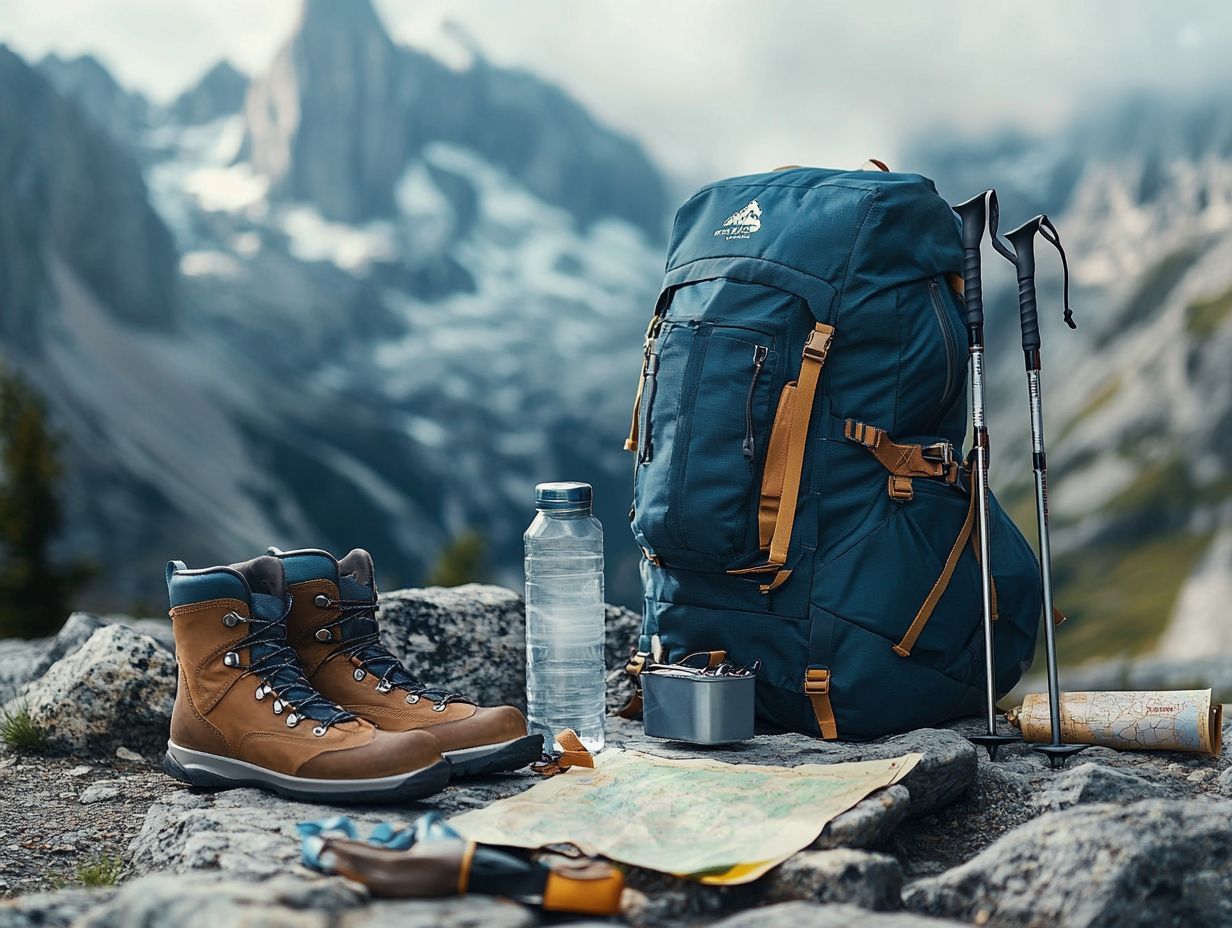
Staying hydrated is essential for your hiking trips. It keeps your energy levels up and fights fatigue during long treks.
You can choose a Smartwater Bottle or a more advanced water pouch. Adding a water filter to your gear lets you refill from natural sources along the trail.
This means you can stay hydrated without carrying extra weight, enhancing your hiking adventure.
When selecting a hydration system, think about your hike duration and available water sources. For short hikes, a basic bottle may work, while longer ones might need a water pouch for hands-free drinking.
A portable water filter is a game-changer. It gives you access to clean water from streams or lakes.
Watch for signs of dehydration, like dizziness or a dry mouth. Take regular sips, even if you’re not thirsty, to keep your energy levels high and enjoy your journey.
7. Sun Protection
Sun protection is critical for hiking safety. Prolonged exposure to UV rays can lead to sunburn and heat-related illnesses.
Use hiking accessories like wide-brimmed hats, UV-blocking sunglasses, and high-SPF sunscreen. These items significantly reduce health risks and boost your outdoor experience.
When you prioritize sun protection, you can fully enjoy your adventures. This is especially important on sunny summer hikes.
Choosing clothing made from UV-resistant fabric adds extra protection. Invest in long-sleeved shirts and lightweight pants designed for outdoor activities.
These clothes help keep you cool while shielding your skin. Remember, the sun’s intensity changes throughout the day, so reapply sunscreen every two hours or more often if you re swimming or sweating.
Staying hydrated is another key factor for outdoor fun. Drinking plenty of water helps your body regulate temperature and prevents overheating.
8. Portable Shelter
A portable shelter is vital for hiking gear. It provides a safe haven from harsh weather and potential emergencies on the trail.
Choose a lightweight tent, tarp, or bivy sack. A dependable shelter protects you from rain, wind, and extreme temperatures, ensuring safety and comfort.
Consider weight and size based on your hike’s duration and intensity. For day hikes, a compact tarp might work well, while multi-day excursions usually require a larger tent.
Portability includes how easily the shelter packs away, not just its weight.
Practice setting up your shelter beforehand. Familiarity with the setup saves time and can be crucial during emergencies.
9. Emergency Communication Device
An emergency communication device is vital for your hiking safety. It allows you to call for help or stay in touch in remote areas where cell service is often unavailable.
Devices like the Garmin inReach provide reliable satellite connectivity. This enables you to send messages and access emergency services if an accident or medical issue arises.
By adding one of these devices to your emergency kit, you are preparing for unexpected situations while enjoying the beauty of the outdoors.
They often come loaded with lifesaving features like GPS tracking, two-way messaging, and SOS functionality. Understanding how these devices work and practicing with them before your adventure is essential.
Regularly testing your device keeps it ready for action and helps you become familiar with its features. This boosts your readiness in critical moments.
Keeping your device charged is crucial don t risk your safety by running out of battery on the trail. Mastering when and how to use these tools can greatly enhance your safety and peace of mind.
10. Multi-Tool
A versatile multi-tool is essential for your hiking gear. It offers many useful features that can elevate your outdoor adventures.
With tools like knives, screwdrivers, and pliers, a multi-tool helps with everything from gear repairs to food preparation. Choosing a compact and lightweight model ensures you have this handy tool without adding unnecessary weight to your backpack.
This adaptability means you can handle unexpected situations, whether mending a broken tent pole or opening a can of food. Popular models like the Leatherman Wave and Gerber Suspension are reliable choices.
Think about your planned activities when choosing a multi-tool. Some come with specialized tools, such as a fishing line cutter or fire starter, which can be particularly helpful in diverse terrains.
Ultimately, a carefully selected multi-tool not only boosts your safety but also improves your hiking experience.
11. Headlamp or Flashlight
A reliable headlamp or flashlight is crucial for your hiking gear. It provides needed light for evening or morning hikes and ensures your safety in low light.
Headlamps are great for hands-free operation, perfect for navigating trails or setting up camp. A compact flashlight also acts as a useful backup for any situation.
Many headlamps have multiple brightness levels, allowing you to adjust the light for different needs. This can be a gentle glow for reading a map or a powerful beam for spotting wildlife at night.
Battery life is important; some models with energy-efficient LEDs can last several nights on one charge. Choose lightweight options for long treks to avoid extra weight.
Carrying spare batteries is a smart precaution. Test your lighting gear before hitting the trail to avoid surprises and ensure a safe, enjoyable hiking experience.
12. Insect Repellent
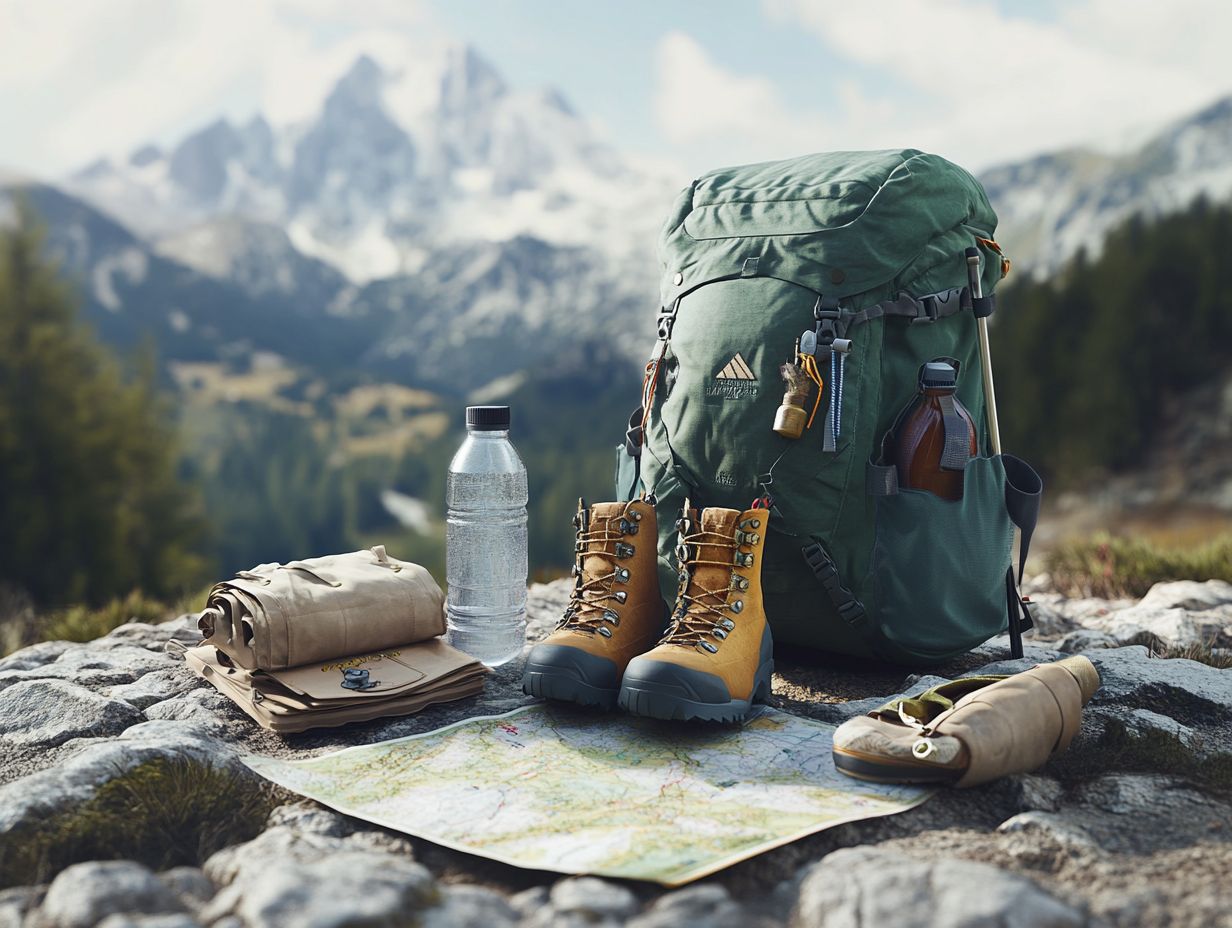
Insect repellent is an important tool in your hiking safety arsenal, safeguarding you from harmful bites and discomfort during your outdoor escapades. By applying a quality insect repellent especially in areas notorious for mosquitoes and ticks you can make your hike more enjoyable and reduce the risk of insect-borne illnesses.
With a variety of options available, including sprays, lotions, and even wearable devices, each formulation harnesses different active ingredients like DEET, picaridin, or natural oils. Assess your hiking locations because certain regions may have unique insect populations that respond better to particular repellents.
Proper application is key to achieving optimal effectiveness; make sure you spray on exposed skin and clothing, paying special attention to those bite-prone areas. Don t forget: reapplication is necessary after sweating or swimming, ensuring lasting protection throughout your hike.
13. Whistle
A whistle is a simple yet powerful tool for enhancing your hiking safety, providing a dependable means to signal for help or alert others in an emergency. Lightweight and compact, it slips effortlessly into your emergency kit, ensuring you have it at your fingertips without sacrificing precious space in your backpack.
Its loud, piercing sound can carry over great distances, making it an important tool for any hiker venturing into the wild. The true effectiveness of a whistle lies not only in its volume but also in its ability to convey distress signals that are universally understood.
In wilderness scenarios, where verbal communication might be hampered by rugged terrain or your physical condition, a whistle can draw attention precisely when you need it most. There are various types of whistles, each with unique features; for instance, an electronic whistle is a whistle that uses batteries to produce different sounds, while a traditional metal whistle boasts durability and a fail-proof design.
A whistle is not just smart to carry; it could save your life. This versatility and resilience mean that incorporating a whistle into your hiking gear is a wise choice.
14. Extra Food and Snacks
Carrying extra food and snacks is a must-have for an unforgettable hiking adventure, providing the energy you need to keep going strong. High-energy snacks like nuts, granola bars, and electrolyte chews can be very helpful, especially on longer treks where maintaining your stamina is key.
By planning your food supply in advance and ensuring you stay well-hydrated, you can significantly elevate your overall hiking experience. To achieve a well-rounded selection, prioritize nutrient-dense options, which are foods that provide a lot of vitamins and minerals for their weight, such as dried fruits, jerky, and whole-grain crackers.
These snacks curb your hunger and promote a steady release of energy. When meal planning, aim for a balanced mix of carbohydrates, proteins, and healthy fats to optimize your performance on the trails.
Equally important is balancing these snacks with adequate water intake, as staying hydrated is crucial to preventing fatigue and aiding recovery. Mind your nutrition and hydration to maximize your energy and enjoyment throughout your journey.
15. Personal Items (ID, Cash, etc.)
Bringing personal items like identification, cash, and emergency contacts is essential for your hiking essentials and overall hiking safety, ensuring you re ready for any situation that might pop up during your outdoor adventure.
Having these items on hand serves as your safety net, allowing you to tackle unforeseen circumstances with greater confidence. To elevate your security, consider using waterproof bags or containers; they can keep your vital documents safe from rain or moisture, especially during heavy rain.
Designating a specific pocket in your backpack for these invaluable essentials helps prevent accidental loss or damage, ensuring quick access when you need it most. Remember, a little preparation goes a long way.
Pack your gear now to ensure a fantastic adventure!
How to Choose the Right Hiking Gear for Your Needs?
Choosing the right hiking gear for your adventures requires careful thought about various factors. Consider the type of terrain, how long you’ll hike, and your comfort preferences.
By evaluating your hiking goals, you can select gear that maximizes your enjoyment and keeps you safe on the trail.
It’s crucial to distinguish between day hiking and multi-day excursions. Day hikes often need lighter, breathable materials, while longer trips require durable fabrics that can endure the elements.
Testing your gear for fit is essential. You want to make sure your hiking shoes won’t give you blisters and your backpack won’t throw off your balance.
Finding the right size and features in your outdoor gear can prevent discomfort and pave the way for a smoother journey. This makes those memorable moments on the trails even more enjoyable.
Frequently Asked Questions
What are the must-have items for hiking in all seasons?
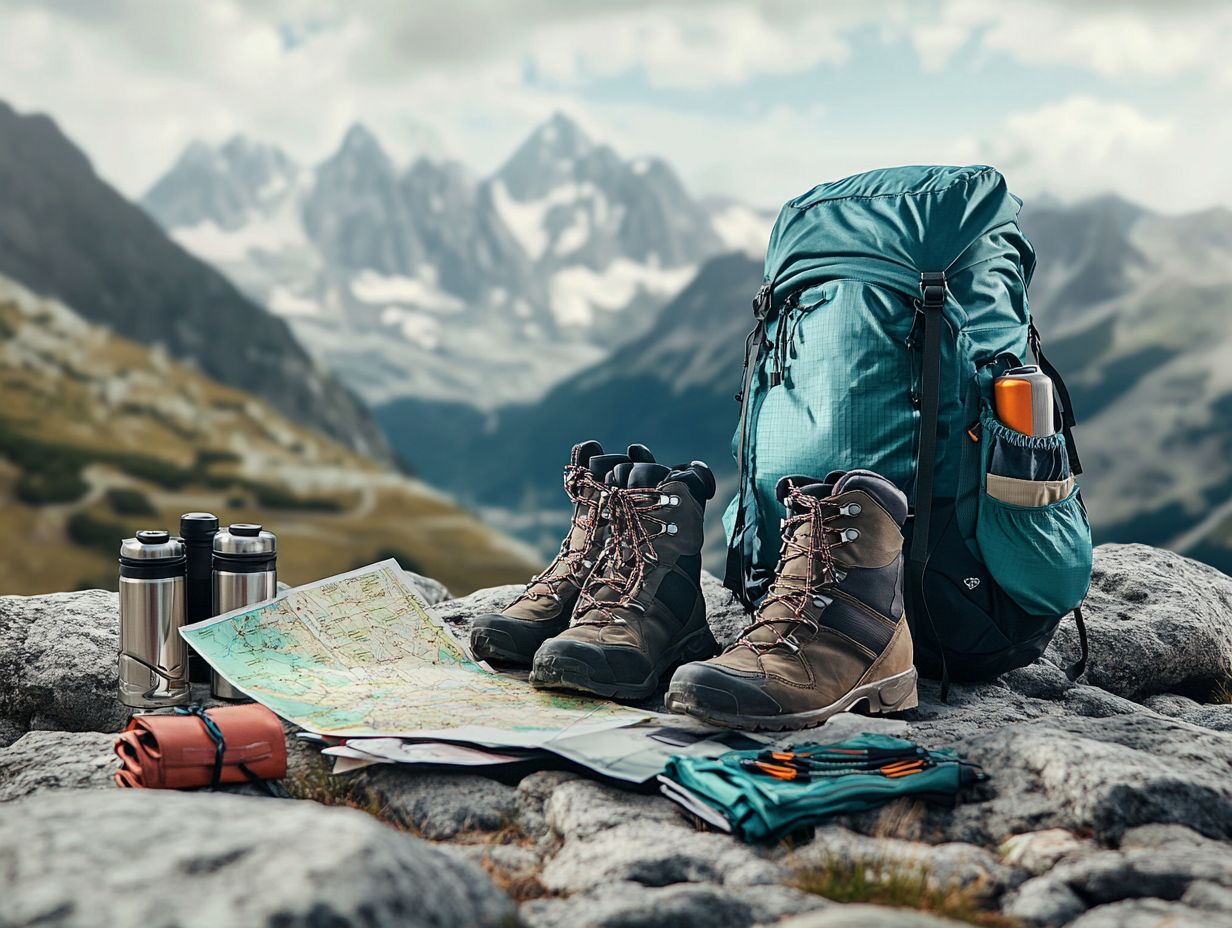
The must-have items for hiking in all seasons include a durable hiking backpack, proper hiking shoes, layers of hiking clothes, a reliable navigation device, a first aid kit, and plenty of hiking snacks.
Why is a durable backpack important for hiking in all seasons?
A durable hiking backpack is important because it keeps your gear safe and organized. It can withstand different weather conditions and terrains.
How do I choose the right hiking boots for all seasons?
When choosing hiking shoes for all seasons, look for waterproof options with good traction and ankle support. Make sure to try them on and walk around in them to ensure comfort.
Why is layering clothing important for hiking in all seasons?
Layering clothing is essential as it allows you to adjust to changing weather and temperature. This ensures that you stay warm and dry throughout your hike.
For hiking in all seasons, a navigation device like Garmin inReach should have GPS capabilities, be waterproof and durable, and have a long battery life. It’s also wise to bring a physical map and compass as a backup or consider using apps like AllTrails or GaiaGPS for additional support.
Why is it necessary to pack a first aid kit for hiking in all seasons?
A first aid kit is necessary for any accidents or injuries that may occur while hiking. It should include basic supplies like bandages, gauze, antiseptic wipes, pain medication, and items like electrolyte chews for quick recovery.
Ready to hit the trails? Pack your bags and enjoy your outdoor adventures!

